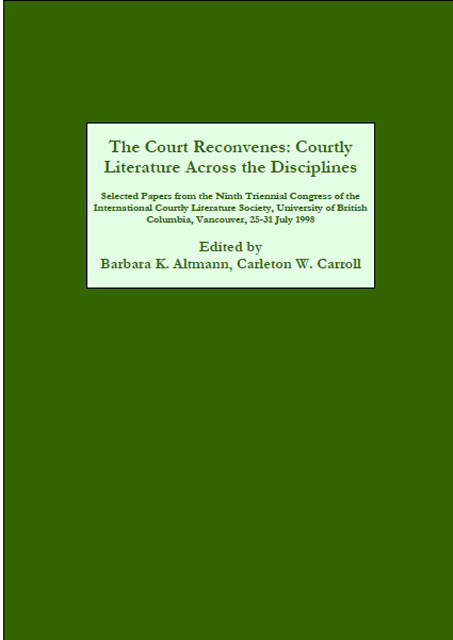 The Court Reconvenes
The Court Reconvenes Embodying the Rose: An Intertextual Reading of Alain Chartier’s La Belle Dame sans mercy
Published online by Cambridge University Press: 31 March 2023
Summary
My argument starts from two propositions. The first is the following: that it is impossible to write a treatise or a tale of love, in later medieval France, other than in the intertextual and dialectical mode imposed by that best-seller of all medieval best-sellers, the Roman de la Rose, and by this I mean without engaging intertextually, in however clumsy or ill-informed a way, with the topoi and the arguments of the Rose. The second is that that engagement concerns primarily language: that the model, or models, of love and sexuality propounded by the Rose are so powerfully destabilising that they inflect all subsequent linguistic behaviours and ideologies. From these propositions will follow the argument of this paper: that to read Alain Chartier's La Belle Dame sans mercy as a euhemerised version of the Rose – that is, as if the large allegorical abstractions of the Rose had been “made human” – is to account for the former's uneasinesses and ambivalences in a way more satisfactory than has yet been the case.
I would be prepared to argue the point even where nothing signaled intertextuality, but as it happens, Alain Chartier, with a certain désinvolture, does invite us to cross-read his poem against the Rose. A narrator, whose own lady has died, has found his way to an evening of gentle entertainment in an orchard. His melancholy makes him unsociable: he finds a seat behind an arbour in the garden. Into the arbour come an anonymous Dame and her Amant; he has in fact already noticed the two of them – the Amant because his melancholy seems to mirror the narrator's own, the Dame because of her cool, unruffled beauty:
En la dame ne failloit riens,
Ne plus avant ne plus arriere.
C’estoit garnison de tous biens
Pour faire a cuer d’amant frontiere:
Jeune, gente, fresche et entiere;
Maintien rassis et sans changier;
Doulce parolle et grant maniere,
Dessoubz l’estendart de Danger. (BDSM 145–52; my emphasis)
The narrator overhears a long debate between the two of them: the Amant straining every rhetorical nerve to persuade the Dame to take pity on him, the Dame remaining mistrustful, and impervious.
- Type
- Chapter
- Information
- The Court ReconvenesCourtly Literature across the Disciplines: Selected Papers from the Ninth Triennial Congress of the International Courtly Literature Society, University of British Columbia, Vancouver, 25-31 July 1998, pp. 325 - 334Publisher: Boydell & BrewerPrint publication year: 2002


